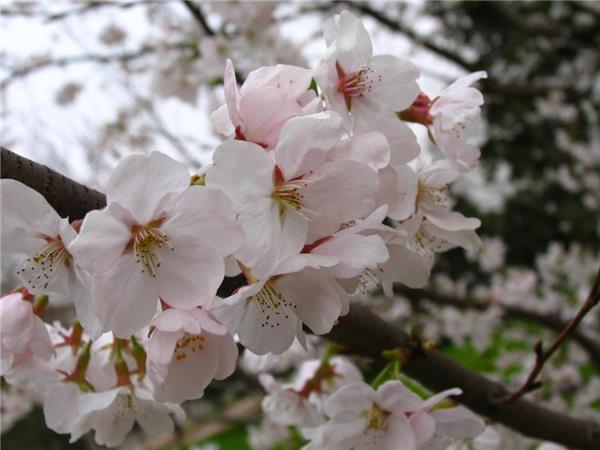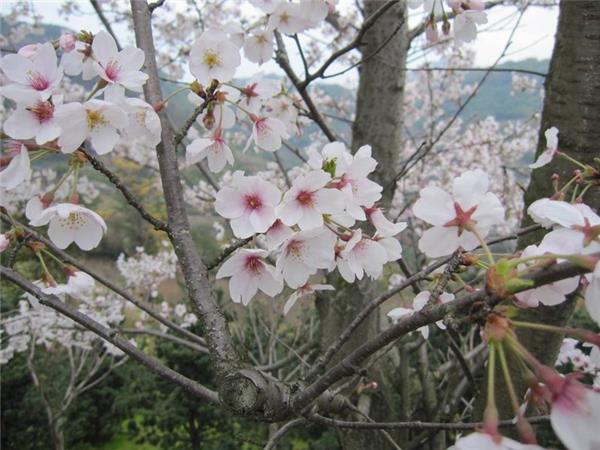The characteristics of Japanese early Sakura the difference between Japanese early Sakura and Japanese late Sakura
Japanese morning cherry is a very good ornamental tree species, many people have been amazed at its blooming and withering mournful and magnificent landscape, which makes it always maintain a high position in people's hearts.

Introduction of Japanese morning Sakura
Morphological features: trees, about 5m high, bark striated, old bark longitudinally split. Branchlets brown, leaves Obovate to ovate-lanceolate. The first leaf of the flower blossoms. Buds pink, oval; pollen white, petals 5, petal tip concave, petal edge red, 1.8cm 2.2cm in diameter; pistil 1, stamens scattered, long and short, long stamens slightly longer than petals, filaments light purplish red; calyx light purple brown, tubular hairy, calyx 5, apex slightly pointed, and often calyx petals 1; pedicels ca. 0.5cm, hairy; flowers 2 flowers in a bunch, sparse 1. After the flower fades, the petals fall off, but the filament can last for a few days, looking like a red cloud from afar. The leaves are hairy. It is easy to bear fruit. 'Japanese morning cherry 'has the phenomenon of different florescence of the same variety in the same place, and the difference is generally 1-2 days.
Garden uses: Japanese morning cherry trees are free and easy to develop, with luxuriant branches, full of trees and beautiful flowers, such as jade trees in full bloom, such as clouds, clouds and snow, which is very spectacular, and is an excellent ornamental plant in garden. therefore, it is often planted in front of buildings, grasslands, hillsides, pools, solitary planting and group planting are very suitable. In summer, Japanese morning cherry trees are luxuriant and shady, and they are also very beautiful and decent as sidewalks or sidewalks. Japanese morning cherry can also be used as a hedge or bonsai.

II. Planting techniques of Japanese morning cherry
Planting technology: the planting time is planted immediately after the soil is thawed in early spring, usually in February and March. Carefully prepare the ground before planting and plant holes with a diameter of 1 meter and a depth of 0.8 meters on flat land. Fill the hole with about half the depth of the improved soil, and put the seedling in the middle of the hole so that the root of the seedling extends in all directions. After a small amount of filling, lift the seedling slightly upward, so that the root system is fully extended, and then tread lightly. The depth of planting seedlings should be 5 meters from the ground of the uppermost roots. After planting, make a water nest, and fully irrigate, and finally with bamboo about the height of the seedling to support, in case the wind blows down.
Growth period management: Japanese morning cherry is fertilized twice a year, and acid fertilizer is better. One was winter fertilizer, which applied organic fertilizers such as bean cake, chicken manure and mature fertilizer in winter or early spring, and the other applied quick-acting fertilizers such as ammonium sulfate, ferrous sulfate and calcium superphosphate after falling flowers. In general, the method of hole application can be adopted for the fertilization of Japanese early cherry trees, that is, at the edge of the canopy: the positive projection line, dig a circular ditch about 10 meters deep, and apply fertilizer. This method is not only simple and beneficial to root absorption, but also increases the diameter and depth of ring trench with the growth of trees. The root distribution of Japanese morning cherry is shallow, which requires good drainage and ventilation, so people, animals and vehicles should not stand firm in the soil around the tree, especially in the range of root distribution. Pedestrian trampling will weaken the tree, shorten its life, and even cause rotten roots to die.

III. The difference between Japanese morning Sakura and Japanese evening Sakura
1. Tree shape difference: Japanese morning cherry trees can be up to 17 meters high, and their bark is gray and striated. Japanese evening cherry bark is silver-gray, with lip-shaped lenticels, up to 8m high.
2. The difference of leaf shape: the leaf of Japanese early cherry is Obovate to ovate-lanceolate, while the leaf of late cherry is oval-shaped, long oval to Obovate.
3. The difference of leaf size: the leaves of early cherry are usually 3 "8" long and 2 "4" wide, while the leaves of late cherry are 5 "12" long and 3 "6" wide. The leaves of late cherry are larger than those of early cherry.
4. The difference between branches and stems: when the early cherry does not have leaves, the bark is striated and the old bark is split longitudinally. The branchlets are brown and the lenticels of the tree stalks are sparse. The new branches are hairy, while the bark of the late cherry is silvery gray. The lenticels on the tree stem are small and many. The new buds are darker in color, dark brown and larger.
5, the difference of flower shape: the petals of early cherry are 5, oval, mostly single white, the flowers look rare, while the flowers of late cherry are light pink when they are not in bloom, and the flowers are brighter and redder when they are in full bloom, and the flowers are double, with fewer leaves and a large number of flowers.

The beauty of cherry trees is world-famous, and it is no wonder that so many love movies and idol dramas like to use cherry blossoms to set the scene. If you have friends at home with suitable conditions, you can also try to plant some cherry trees. Japanese early cherry trees are not necessarily necessary, because as long as they are cultivated properly, every cherry tree will grow beautifully.
You can also try to plant some cherry trees, and Japanese early cherry trees are not necessary, because as long as they are cultivated properly, every cherry tree will grow beautifully.
- Prev

Planting techniques and daily management and protection techniques of loquat trees
Planting techniques and daily management and protection techniques of loquat trees
- Next

Can pregnant women drink chrysanthemum tea? the efficacy of chrysanthemum tea
Can pregnant women drink chrysanthemum tea? the efficacy of chrysanthemum tea
Related
- Wuhan Hospital Iron Tree Blooming Result Was Instantly Frightened by the Gardener Master
- Which variety of camellia is the most fragrant and best? Which one do you like best?
- What is the small blue coat, the breeding methods and matters needing attention of the succulent plant
- Dormancy time and maintenance management of succulent plants during dormancy
- Minas succulent how to raise, Minas succulent plant pictures
- What are the varieties of winter succulent plants
- How to raise succulent plants in twelve rolls? let's take a look at some experience of breeding twelve rolls.
- Attention should be paid to water control for succulent plants during dormant period (winter and summer)
- Watering experience of twelve rolls of succulent plants
- Techniques for fertilizing succulent plants. An article will let you know how to fertilize succulent plants.

